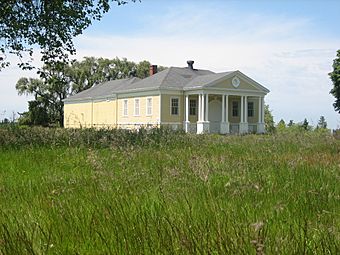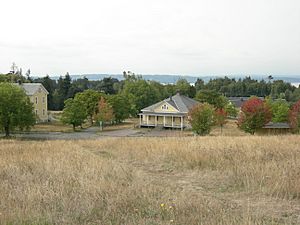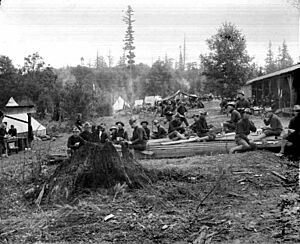Fort Lawton facts for kids
Quick facts for kids |
|
|
Fort Lawton
|
|

Fort Lawton post exchange and gymnasium
|
|
| Location | Seattle, Washington |
|---|---|
| Built | 1900–1917 |
| Architectural style | Colonial Revival |
| NRHP reference No. | 78002752 |
| Added to NRHP | August 15, 1978 |
Fort Lawton was an important U.S. Army base located in the Magnolia area of Seattle, Washington. It was built on a hill overlooking Puget Sound. In 1973, a large part of the fort's land, about 534 acres, was given to the city of Seattle. This land became Discovery Park, a popular public park. The fort and a nearby neighborhood are both named after Major General Henry Ware Lawton, a brave soldier.
Before World War II, Fort Lawton was a quiet place. But during the war, it became the second-largest place where soldiers and supplies left to go to the Pacific Ocean battlefields. The fort was officially closed on September 14, 2011.
Contents
History of Fort Lawton
In 1896, the U.S. government decided to build a fort in this area. It was meant to protect Seattle and the southern Puget Sound from attacks by ships. Local people and governments donated about 703 acres of land to the Army for the fort.
Fort Lawton was named after Major General Henry Ware Lawton (1843–1899). He was a hero who fought in the American Civil War, the Indian Wars, and the Spanish–American War. He was killed in battle in the Philippines. The fort officially opened on February 9, 1900, on a large piece of land.
The fort was redesigned in 1902 for infantry (foot soldiers). In 1910, a new plan was made to include homes for officers and soldiers. This plan was created by a famous landscape architect named John C. Olmsted. In 1938, during the Great Depression, the Army offered to sell Fort Lawton back to Seattle for just one dollar. However, the city said no because they were worried about the costs of keeping it up.
Early Events at Fort Lawton
Fort Lawton was used as a gathering place for soldiers heading to China. These soldiers were going to help with the Boxer Rebellion, a conflict in China. A Seattle photographer, Theodore E. Peiser, took pictures of the horses, soldiers, and ships leaving Seattle for China.
Buffalo Soldiers at Fort Lawton
On October 5, 1909, the 25th Infantry Regiment arrived at Fort Lawton. This regiment was mainly made up of African American soldiers. They had been serving in the Philippines. These brave soldiers are famously known as the Buffalo Soldiers. The first 900 men and their families who came to the fort made up about one-third of Seattle's African American population at that time.
Fort Lawton During World War II
During World War II, Fort Lawton was a very busy place. At times, at least 20,000 troops were stationed there. More than 1 million troops passed through the fort before and after the war. It was the second-largest port where U.S. forces and supplies left for the Pacific Ocean battlefields.
The fort also held prisoners of war (POWs). Over 1,000 German POWs were held there. About 5,000 Italian POWs passed through on their way to Hawaii. On August 15, 1944, an Italian POW was found dead after a night of trouble between Italian POWs and American soldiers. Many African-American soldiers were later found responsible and sent to prison. Years later, after an investigation, their convictions were overturned in 2007. The Army held a special ceremony in 2008 to apologize to the soldiers' families and the few survivors.
In 1951, a special area with trees and a monument was dedicated near the fort's chapel. It honored those who died in wars. The Korean War also brought a lot of activity to Fort Lawton. Troops going to or returning from Korea were processed there. In 1960, the Air Force set up a radar station at Fort Lawton. Anti-aircraft missiles were also used there for a time.
Native American Occupation
In 1970, a group of Native Americans occupied the fort for three weeks. They were led by Bernie Whitebear, Ella Aquino, and Ramona Bennett. They believed that the land, which the Army no longer needed, should belong to Native Americans. They succeeded in getting 40 acres of land for the Daybreak Star Cultural Center. The rest of the land, about 534 acres, was given back to the city of Seattle in 1972. It officially became Discovery Park in 1973.
Closure of Fort Lawton
In 2005, Fort Lawton was put on a list for closure. The homes for military families at the fort were sold to a private company. These homes were remodeled and are now privately owned. The Capehart Housing area in the middle of the park was emptied and torn down in 2010. That land is now part of Discovery Park.
Fort Lawton officially closed on September 14, 2011. The last Army Reserve unit moved to a new location. A closing ceremony was held on February 25, 2012. Most of the remaining fort property, except for the military cemetery, was given to the City of Seattle in 2012. There are plans to build affordable housing on part of the property.
Historic Buildings at Fort Lawton
The Fort Lawton Historic District is located within Discovery Park. It contains many old buildings and structures that were part of the fort. Here are some of the notable buildings that still exist or existed until recently:
- Administration Building (built 1902): This was likely where the fort's leaders worked.
- Officers Quarters (built 1899-1904): These were homes for the officers and their families.
- Post Gymnasium (built 1942): A place for soldiers to exercise.
- Post Exchange and Gymnasium (built 1905): This building served as a store for soldiers and also had a gym.
- Band Barracks (built 1904): Where the fort's band members lived.
- Civilian Employees Quarters (built 1908): Homes for people who worked at the fort but were not soldiers.
- Guard House (built 1902): Where guards were stationed and sometimes prisoners were held.
- Bus Stop (built 1949): This old bus stop was even used in a movie!
- NCO Quarters (built 1899-1933): Homes for non-commissioned officers, who are experienced enlisted soldiers.
- Quartermaster Stables (built 1902-1908): Where horses were kept and cared for.
The Chapel-on-the-Hill
The Chapel-on-the-Hill is a special building located outside the main Historic District. It is considered a city landmark. In 2008, the City Council voted to include the Chapel and its grounds as part of the Fort Lawton Landmark District.
Images for kids














